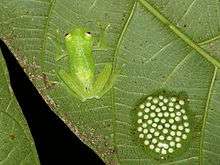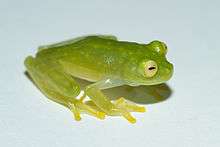Bare-hearted glass frog
| Hyalinobatrachium colymbiphyllum | |
|---|---|
 | |
| Scientific classification | |
| Kingdom: | Animalia |
| Phylum: | Chordata |
| Class: | Amphibia |
| Order: | Anura |
| Family: | Centrolenidae |
| Subfamily: | Hyalinobatrachinae |
| Genus: | Hyalinobatrachium |
| Species: | H. colymbiphyllum |
| Binomial name | |
| Hyalinobatrachium colymbiphyllum (Taylor, 1949) | |
| Synonyms | |
|
Centrolenella colymbiphyllum Taylor, 1949 | |
The bare-hearted glass frog (Hyalinobatrachium colymbiphyllum),[2][3] also called the plantation glass frog and the cricket glass frog, is a species of frog in the Centrolenidae family that is found in moist forests, often near streams, in countries in Central America and South America.[4] They are small, green frogs with many similarities to other glass frogs, however they have the most transparent undersides of any glass frogs. Their transparent undersides make them ideal bio-indicators for how global warming and other threats are affecting the animals in the forests.
Characteristics

Bare-hearted glass frogs are similar in features to most glass frogs but have their own distinct characteristics. Like most glass frogs, they are small and green with yellow spots, and transparent undersides. The transparent undersides are the main feature of most glass frogs, but the bare-hearted glass frog has the clearest underside, allowing almost full visibility of their internal organs.[5] Their transparent skin also makes them difficult to see, as well as their size.[6] They are very small, with male frogs being 22–27 mm long and females 24.5–29 mm long. Other distinct characteristics of bare-hearted glass frogs are their forward-facing golden eyes and nostrils raised from their heads. They spend time moving throughout the forests and streams, their front fingers being less webbed and more isolated, while their back feet are heavily webbed, allow them mobility in trees and in water.[7]
Bare-hearted glass frog tadpoles are very small, less than 9.5 mm. They are brown with light undersides and have long bodies with pointed tails for swimming while they mature in the streams.[3]
Habitat
The bare-hearted glass frog is found in Honduras (Olancho Department), central and southeastern Costa Rica, Panama, and western Colombia along the western slopes of Cordillera Occidental.[2][8] They live near streams, or other bodies of water, that are surrounded by rainforests. During breeding season they live beside or directly above streams on leaves and bush that dangle over the water in order for eggs to hatch into the stream.[9] The Costa Rican Amphibian Research Center (CRARC), founded by Brian Kubicki, has found that they live higher in trees or near waterfalls while not in breeding season.[4] There is not much research on what they eat, but like most frogs they probably eat small insects.[6]
Since they rely on the presence of trees, they are most threatened by the destruction of their habitat from deforestation.[3] Even though they face threats to their environment, according to the International Union for Conservation of Nature, they are considered to be "least concern" for extinction.[1] However, with many other glass frogs declining in population, bare-hearted glass frogs are also at risk.[4] Global warming is also a threat to bare-hearted glass frogs. They need moisture and rain in order to not dry out, and lack of rain or warmer conditions can be dangerous.[6] Biologists are interested in further researching and observing bare-hearted glass frogs as they can be good bio-indicators of how global warming is affecting, not only frogs, but other species in rainforests.[6]
Breeding
Breeding season is during rainy season, from late fall to spring. The process of breeding starts with males selecting a leaf or bush near a stream as their calling ground. Then they call to attract females, the sound is similar to a cricket, which is where they get one of their common names from.[10] They stay in one spot to call from and will fight other males for territory and to win females. The fights between males are over a specific leaf or calling area and are won by one male pinning the other down. Once they attract a female, the eggs are laid on the underside of a leaf.[5] Batches are 50-75 eggs, and are laid under leaves above streams where they are cared for by the male. The male's responsibility is to protect and keep the eggs moist, he does this through urination and osmosis (a process where water passes through the skin).[4] Due to the nocturnal nature of the frogs, the male guards the batch during the night but eggs are stolen by wasps when they are not guarded. The wasps steal the eggs one at a time and can steal entire batches while the eggs are not guarded during the day.[5] The eggs are cared for and mature while on the leaf for about two weeks.[4] Once the eggs hatch, they either wiggle until they drop into the streams or are washed off the leaves by the rain in to the streams,[3] where they finish their larval development.[1]
References
- 1 2 3 Solís, F.; Ibáñez, R.; Chaves, G.; Savage, J.; Jaramillo, C.; Fuenmayor, Q.; Castro, F.; Grant, T.; Wild, E.; Acosta-Galvis, A. & Kubicki, B. (2008). "Hyalinobatrachium colymbiphyllum". IUCN Red List of Threatened Species. IUCN. 2008: e.T55007A11236164. Retrieved 11 November 2015.
- 1 2 Frost, Darrel R. (2015). "Hyalinobatrachium colymbiphyllum (Taylor, 1949)". Amphibian Species of the World: an Online Reference. Version 6.0. American Museum of Natural History. Retrieved 11 November 2015.
- 1 2 3 4 "AmphibiaWeb - Hyalinobatrachium colymbiphyllum". amphibiaweb.org. Retrieved 15 October 2015.
- 1 2 3 4 5 Butvill, David Brian (4 January 2008). "Shining a Light on Glass Frogs". National Wildlife Federation. National Wildlife Federation. Retrieved 20 October 2015.
- 1 2 3 "Cricket Glass Frog (Hyalinobatrachium colymbiphyllum) - The Night Tour - Drake Bay, Costa Rica". www.thenighttour.com. Retrieved 21 October 2015.
- 1 2 3 4 "Glass Frog". www.svsu.edu. Archived from the original on 15 February 2016. Retrieved 8 November 2015.
- ↑ "Descriptions and articles about the Plantation Glass Frog (Hyalinobatrachium colymbiphyllum) - Encyclopedia of Life". Encyclopedia of Life. Retrieved 21 October 2015.
- ↑ "Hyalinobatrachium colymbiphyllum Taylor 1949". Amphibians of Panama. Smithsonian Tropical Research Institute. Retrieved 11 November 2015.
- ↑ "Glass frogs, the beautiful transparent frogs from the amazon". Mudfooted.com. Retrieved 21 October 2015.
- ↑ Lindsay (24 October 2011). "Through the looking glass…". amphibianrescue.org. Amphibian Rescue and Conservation Project. Retrieved 21 October 2015.
